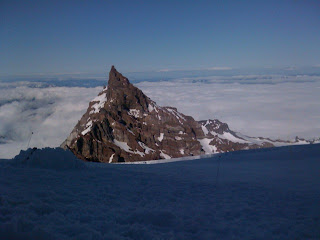Currently conditions on Rainier are excellent. Our last 6 climbs on the Muir route have had near 100% climber success. Weather has been good, with clear skies above a regular marine layer of clouds that usually exists between the 5000’ & 10,000’ elevations. Once our groups ascend through and above this layer of clouds (sometimes getting rained or snowed on in the process) we are blessed with clear skies and excellent views from our camp on the first night just above 10,000’, Camp Muir. Typically we can see volcanoes such as Mt. Adams, Mt. St. Helens & Mt. Hood (& sometimes Mt. Jefferson) to the south popping up through the cloud layer. If this “marine” layer of cloud dissipates during the day then occasionally we have unobstructed views, which from the summit can be absolutely amazing (imagine the Puget Sound, Olympic Mountains, North Cascades, & cities of Seattle & Tacoma visible from the top!). Winds have been present, sometimes up to 40 or 50 mph on the summit, not strong enough to prevent us from climbing to the top, but definitely noticeable and adding some to the challenge of ascending to 14,411.’
The Disappointment Cleaver climbing route on our 3 day Muir programs is in excellent condition. With all of the snowfall this spring there is significant accumulation from the 10,000’ to 12, 500’ levels, making for a more direct climb with favorable walking surfaces (late season much of the snow can melt off the glaciers & rocks making for icy & rocky walking conditions, snow is much easier to walk on). Our climb from Camp Muir to our high camp at the Ingraham Flats on the glacier is currently very good, because of the snow covering the rocks in the Cathedral Gap & ridge areas, as well as the snow that has filled in the crevasses on the Cowlitze Glaciers and the east side of the Ingraham Glacier that we briefly cross before arriving “high camp”. Above this camp, the route is very smooth, as we climb up the Ingraham Glacier and cross beneath the Ingraham “icefall” and onto the Disappointment Cleaver ridge. Because this ridge currently has significant snow on it, we are able to climb almost directly up the ridge line, to the top at about 12,300’ where we stop to take a rest break. From this point our climbing route climbs up and East onto the Emmons Glacier and weaves through large crevasses, before reaching our “high break” at about 13,300’. This section contains some very large crevasses that we either cross by stepping over or by finding a suitable snow bridge that exists. From “high break” we climb roughly another 1000’ to the crater rim and into the crater where we break before crossing to the true summit, Columbia Crest. The crater is filled with snow and is a safe zone for us to walk casually unroped, we try to sign the summit register & take a few “glory shots” on Columbia Crest with views of Liberty Cap behind.
As summer in the Pacific Northwest begins and temperatures warm up, much of the snow accumulation over the winter and spring will melt, causing the climbing route to change significantly. Our route will begin weaving more frequently around crevasses that become exposed, we will climb on exposed rock, ice, and may even begin using ladders or rope to assist & maintain safety as we ascend & descend the mountain. Last summer, we were able to summit on our last Rainier Muir climbing program at the very end of September. The conditions were very different than early season, the route was noticeably more challenging, but we were able to manage the conditions and maintain safety while climbing to the top and back. Hopefully this summer, because we have begun the climbing season with ample snow accumulation, we will have good conditions throughout the regular climbing season & enjoy many more summits of Mt. Rainier!
Wednesday, June 22, 2011
Tuesday, June 21, 2011
Subscribe to:
Posts (Atom)
